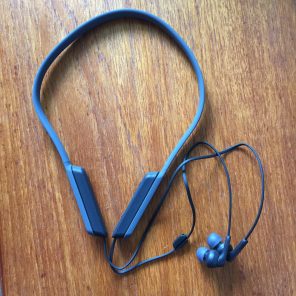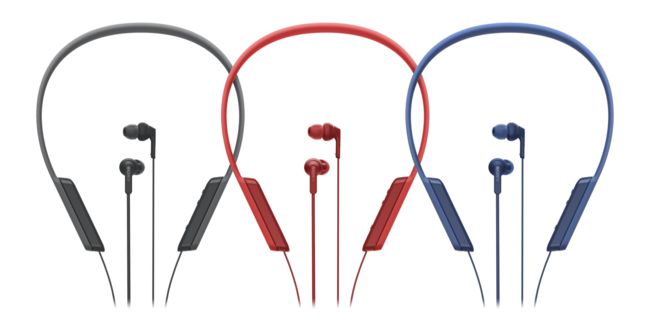 Trying to find just the right pair of headphones to use for sports or activities can be challenging. Each different type of headphone has pros and cons when it comes to bringing it to the gym.
Trying to find just the right pair of headphones to use for sports or activities can be challenging. Each different type of headphone has pros and cons when it comes to bringing it to the gym.
What do YOU want in a sports headphone?
For me personally I have a very short list of things I demand from sports headphones; excellent noise isolation abilities to keep out the annoying gym music, an excellent seal; also to keep out annoying music and loud phone-talkers who insist on sharing their conversations on the treadmill. I also want headphones that stay put properly, and that sound great whether I’m listening to music or watching TV.
I dislike over ear and on-ear models when I’m exercising because I can feel the sweat building up underneath the cushiony pads and getting all slimy.
For all those reasons I’ve come to prefer wireless in-ear headphones for sports and activities. That’s primarily because if I’m trying to run or use machines, I find it annoying getting caught up in a cable that runs from my phone to my head, and I like the noise isolation properties the in-ear seal gives me. Plus, if you take into account the fact that pretty soon earphones will no longer have the cords (thanks Apple) it’s probably a good idea to get accustomed to wireless Bluetooth headphones now.
Testing two pairs of wireless headphones from Sony
Recently I was able to test some new wireless in-ear models that are specifically geared towards sports use. I received the Sony MDR–XB80BS extra bass wireless headphones in red, and the Sony MDR–XB70BT wireless headphones in grey. In this review, I’ll sometimes refer to them and include their colour just to keep things straight.
Sony Sports headphones – Features
Both of these sets of headphones have some of the same properties:
Wireless technology
In some cases ‘wireless’ is a bit of a misnomer when it comes to headphones. For the most part, technology has not (until recently) sufficiently advanced to allow the headphones to operate totally independently from each other.
That is of course changing now that Apple has brought out its new AirPods, and Samsung has started selling its IconX wireless earbuds. But up until now, most wireless earbuds have had some kind of cable connecting them. As such, ‘wireless’ in this case means they lack a wire that connects that headphones to your smart phone or device. Both pairs of Sony extra bass headphones I’m testing have a wire connecting the left and right ear buds.
Extra bass technology
Sony created its ‘Extra Bass’ technology to provide better bass than traditional speakers and headphones have had.
In Sony’s speaker line, the Extra Bass function digitally boosts low-frequencies in the music and “maximizes the deep, punchy sound and rhythmic feel that bass-lovers dream of,” explains Sony on its website.
 In headphones, the technology is similar; but larger drivers are required than you’ll find in traditional headphones, so in the case of both sets I reviewed they are a bit larger than basic earbuds. The red ones have large ear loops that hide the bass drivers, while the grey headphones have it housed in the neckband.
In headphones, the technology is similar; but larger drivers are required than you’ll find in traditional headphones, so in the case of both sets I reviewed they are a bit larger than basic earbuds. The red ones have large ear loops that hide the bass drivers, while the grey headphones have it housed in the neckband.
Voice guidance & easy set up
These headphones feature guided set-up; not that you’ll need them. Both pairs were dead simple to set up; just power them on, and connect to them via your device’s Bluetooth menu. The connection is immediate and it reconnects each time you power them on. (Some users may be disappointed to learn you can only connect these headphones to one device at a time. I’ve used other wireless headphones to connect to my iPad while watching TV at the gym, and since they also connect to my iPhone, I’m able to take calls or hear alerts from my phone. A handy feature for sure, but I can make due without it.) The voice guidance feature will verbalize what you’re doing or the buttons you’re pressing so that you don’t need to take the headphones off to find the controls.
Android users also have the benefit of available one touch NFC or Near Field Communication that connects when in proximity of the device.
Built in Mic for phone calls
Each pair of these Sony headphones has a built in microphone for easy handsfree calling, and they are fully rechargeable.
Other features
Keeping an eye on the battery level for these two headphones is easy; a tiny battery status indicator displays on your iPhone’s connection menu. Each pair has a different battery life, so I’ll cover those below.
These Sony headphones also come with carrying cases and various sizes of silicone rubber replacement earbuds, and they’re washable so you can keep the sweat off.
Sound Quality
The sound on both pairs of Sony headphones is outstanding. The bass is noticeably more powerful and you can really feel it. The audio overall sounds great, whether I was listening to music, podcasts or TV on my smartphone. I have no complaints about the sound quality of these headphones at all.
Testing the fit of the Sony MDR-XB80BS and the Sony MDR XB70BT
General fit
The earbuds fit well on both pairs, thanks to the varying sizes of silicone tips. They both made a really good seal, and I was able to get excellent noise isolation so I could really focus on my music.
When I was sitting and listening to content they fit firmly, didn’t budge and never felt like they were going to fall out.
Both pairs have tiny clips attached to the ear-to-ear cable that will hold it together to prevent slipping and floppy cords. Without the clips, I found the heavy band on the Grey MDR XB70BT would slide around my neck and rest on my collarbone if I moved around too much. That was quite annoying, but with the clip in place, that ceased.
I found I didn’t need the clips with the red MDR–XB80BS headphones; since the drivers sit on your ears, there’s no tugging.
Fit at the Gym
The grey MDR XB70BT fit well even during jogging, yoga or stretching. I noticed them most when doing exercises like toe-touches; the neckband would fall kind of heavily under my chin when I bent over, which was a bit annoying. I will say that I did start to forget the neckband was there the rest of the time; it’s not so heavy or obtrusive as to be fully distracting.
When jogging, I never felt like the earbuds were going to slip out; they fit well and feel very secure, even if the neckband shifts.
The red MDR–XB80BS had a similarly secure fit during the same exercises. When bending over, there was no neckband to contend with but the ear-hooks did take a bit of getting used to. I was worried they’d come lose, but they never did. They always felt secure no matter how I was moving.
Getting specific
My thoughts- Red Sony MDR-XB80BS
While these headphones look big and heavy, they’re comfortable to wear. The drivers are housed in the curved ear hooks, so they stay in place fairly well, thanks in part to gravity.
The headphones are rechargeable with a USB cable. They also have a special feature which allows quick charging; with just 10 minutes of charging, you can get an hour of use out of them. Otherwise you can expect about seven hours of battery life on a single charge.
My thoughts- Grey Sony MDR XB70BT

These headphones look very different. A strangely long cord links the earbuds to each other and they’re attached to weighty silicone rubber neckband with thumb sized ends where the bass drivers are housed.
A tiny clip allows you to hold the wires together and thus keep the neckband or the earphones from slipping out of place. I found it fussy to get the cable snapped into place in the tiny clip, and had to take them off to get it adjusted. I actually broke a nail (gasp! I know!) trying to wedge the cord into the clip so I’d characterize the clip as ‘fussy’ to use. Even so, after I had it properly clipped I was able to take the headphones on and off by sliding the clip along the cables to tighten or loosen it and that made the experience a lot less fussy.
The battery on this pair lasts a maximum of 9 hours, and it too is rechargeable. I made three hours of phone calls using these headphones and they lasted the entire session, plus the sound was great on my end, and my call recipients said the audio was great on their end too. I found these headphones comfortable to wear for the entire session, and it was easy to pull an earbud and drop it to have a conversation, then pop it back in again after.
Overall
I liked both these headphones; they have great sound, they’re easy to use and set up and they both hold tight during use. If I had to pick a favourite, it would be the red MDR–XB80BS or the ear hook version. I liked the way the headphones clipped around my ears, they held pretty steady and the cable that ran around the back of my head was barely noticeable. By comparison, the MDR-XP70 BT or the gray headphones had the heavy, wide rubber neckband that often felt like it needed adjusting. In fact, even if I was just sitting on my couch and getting up and down, if I didn’t have the wires properly clipped together, the neckband would slide down to one side of my collarbone. But wile each of these headphones has a fit feature that may require getting used to, I found that after a couple days of use each one felt comfortable and I stopped comparing one to the other.
In short, I’d definitely recommend both of these for great sound, strong bass, ease of use and overall comfort.




Does wire on the XB80BS cause any disturbance when you run?
Comments are closed.